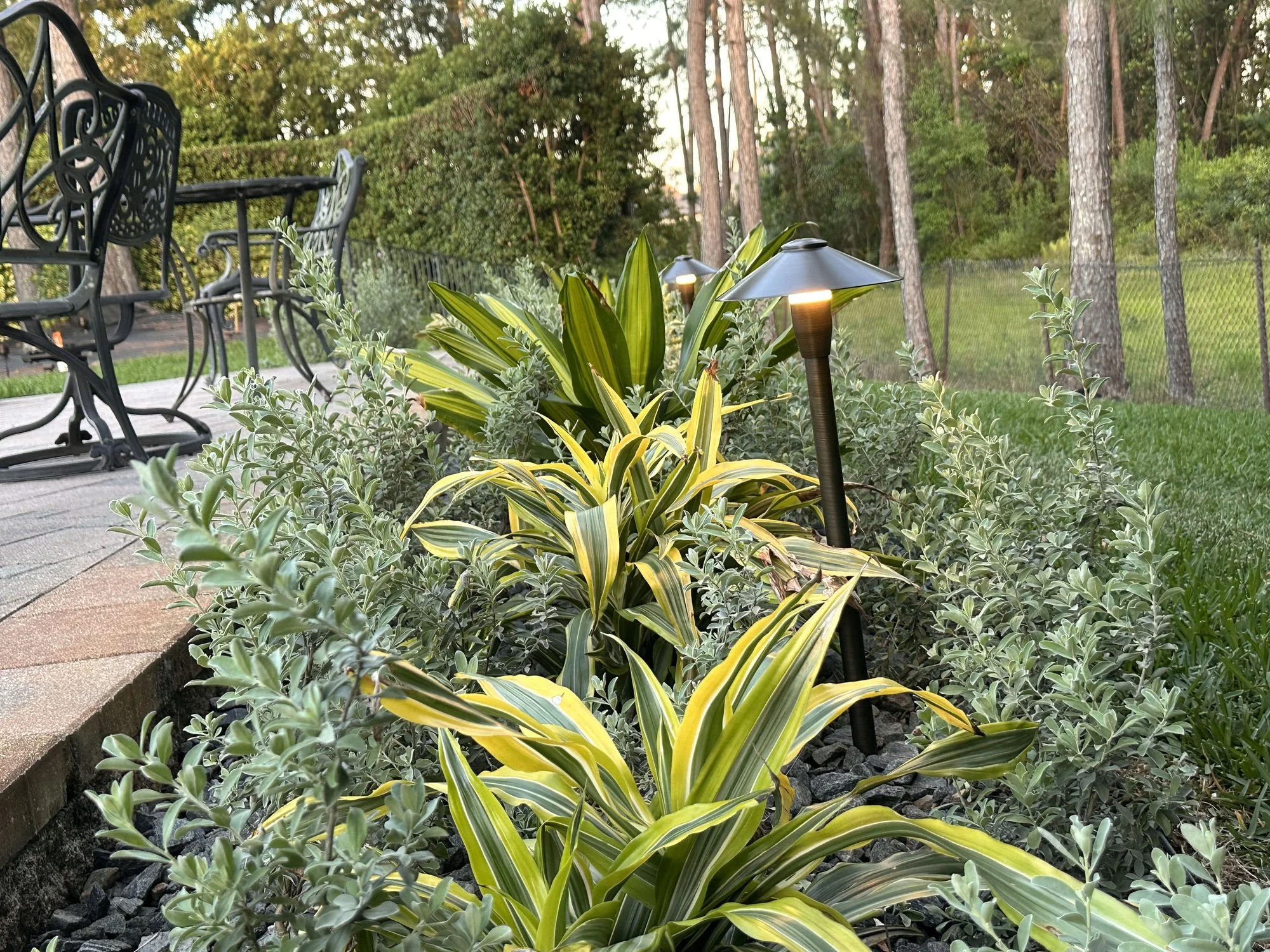Landscape Lighting Fixture Materials: What You Need to Know Before You Buy
Why Fixture Material Matters
Fixture material is one of the most important — and most overlooked — aspects of a long-lasting landscape lighting system. Even the best LED won’t last if it’s housed in a fixture that warps, corrodes, or overheats.
We’ve replaced countless systems across Central Florida where the lights still technically worked — but the housings were cracked, rusted, or completely failed due to poor material choice. Fixture material impacts:
Heat rejection (critical for LED lifespan)
Corrosion resistance (especially in mulch beds, irrigation zones, or coastal air)
Mechanical durability (threads, fasteners, seals)
Maintenance needs and long-term cost
Overall system longevity
Here’s a breakdown of the most common fixture materials — and which ones we trust.
Entry-Level Aluminum Fixtures – Lightweight, Affordable, and High Risk
Many mass-market or big-box lighting kits use thin, powder-coated aluminum. While technically corrosion-resistant at first, the coating often breaks down quickly under Florida’s heat, humidity, and exposure to mulch, irrigation spray, or fertilizers.
Common issues:
Pitting, flaking, and bubbling of the finish
Threaded parts seizing or stripping
Paint fading and exposing the base metal
Weak heat rejection → reduced LED lifespan
Why it's used:
It’s cheap, lightweight, and easy to manufacture.
Why we avoid it:
It doesn’t last — especially in-ground or near irrigation.
Aluminum Alloy Fixtures – Application-Specific, Not One-Size-Fits-All
Top-tier manufacturers like FX Luminaire use high-grade aluminum alloys with professional powder coating, advanced optics, and sealed internal components. These are significantly more durable than entry-level aluminum — and can perform very well when used appropriately.
That said, aluminum still has some inherent limitations compared to brass and copper:
Lower thermal mass = less efficient heat rejection
Can corrode if coatings are damaged or improperly installed
Better suited to dry or elevated mounting locations (walls, trees, pergolas)
Our approach
We’ll spec aluminum alloy fixtures when weight, form factor, or mounting height makes them the right tool for the job. But we typically avoid them for in-ground installs, mulch beds, or zones exposed to regular moisture.
Brass – Our Workhorse Material
Brass is one of the best fixture materials available — and it’s our default for most of the systems we install.
Why? Because it’s strong, corrosion-resistant, and handles heat better than aluminum. It also looks great as it ages, developing a natural patina that blends into the landscape rather than flaking or rusting.
Key Advantages
Excellent heat dissipation → protects LED lifespan
Natural corrosion resistance (no coating required)
Withstands mulch, irrigation, salt, and soil contact
Threads stay clean, fasteners stay serviceable
Heavy and solid — it feels like quality
You’ll find brass in our Essential LED and Premium Integrated packages — and it’s the material we trust for anything installed in-ground or near water.
Learn About our Essential LED Package
Learn About our Premium Integrated Package
Copper – Beautiful, Durable, and Premium
Copper shares many of the same benefits as brass, with a bit more visual flair. It’s naturally antimicrobial, extremely corrosion-resistant, and develops a rich patina over time that’s popular in high-end or historic landscape designs.
Pros:
Top-tier corrosion resistance
Excellent thermal performance
High-end aesthetic appeal
Longest lifespan of all fixture materials
Cons:
More expensive than brass
Slightly softer (can dent if mishandled)
Can leave stains on pavers or stone if installed incorrectly
We typically spec copper in custom or showcase applications, or when requested for visual harmony with gutters, flashing, or copper roof accents.
Stainless Steel – Rare and Mostly Overkill
Stainless steel is very strong but has drawbacks in outdoor lighting. It doesn’t reject heat as well as brass or copper, and cheap stainless (like 304-grade) can still rust in Florida’s coastal and humid climate.
Heavy and difficult to service
Prone to surface corrosion if not marine-grade (316)
Poor thermal conductivity → can trap LED heat
Usually reserved for niche architectural fixtures
Verdict:
Not our go-to. We can spec it in rare cases, but brass and copper offer better overall performance.
What We Use at Ecotek — And Why
We use professional-grade fixtures built with brass or copper in nearly every application — especially in mulch beds, near irrigation, or anywhere that durability matters.
In select cases (like bistro lighting, soffit-mounted downlights, or decorative accents), we may use aluminum alloy fixtures from proven manufacturers — but only when the application, environment, and mounting justify it.
Every fixture we install is chosen based on:
Corrosion resistance
Heat rejection
Thread and fastener quality
Visual longevity and serviceability
No gimmicks. No shortcuts. No “lifetime warranty” fixtures that disintegrate in 18 months.
Learn More About Us
Learn More about our Premium RGBW Package
Want a Lighting System That’s Built With the Right Materials?
We build systems that last — not just until the first rainy season, but for years to come. If you’re tired of replacing rusted fixtures or paying for overpriced warranties, we’ll show you what real quality looks like.
Learn More about our Lighting Packages
Contact Us
Cheap Fixtures Fail Fast. We Build for the Long Run.
Choose brass, copper, and expertise. Let’s build something that lasts — and looks better every year. Fill out the form below, and we will reach out to schedule the next steps.

